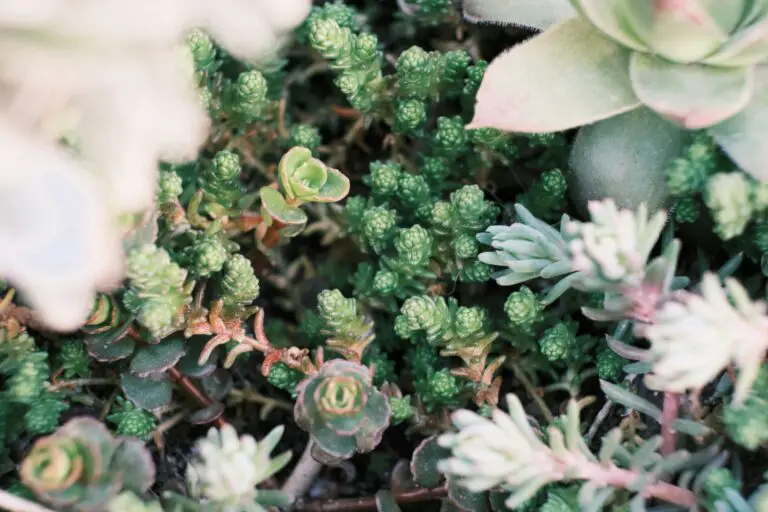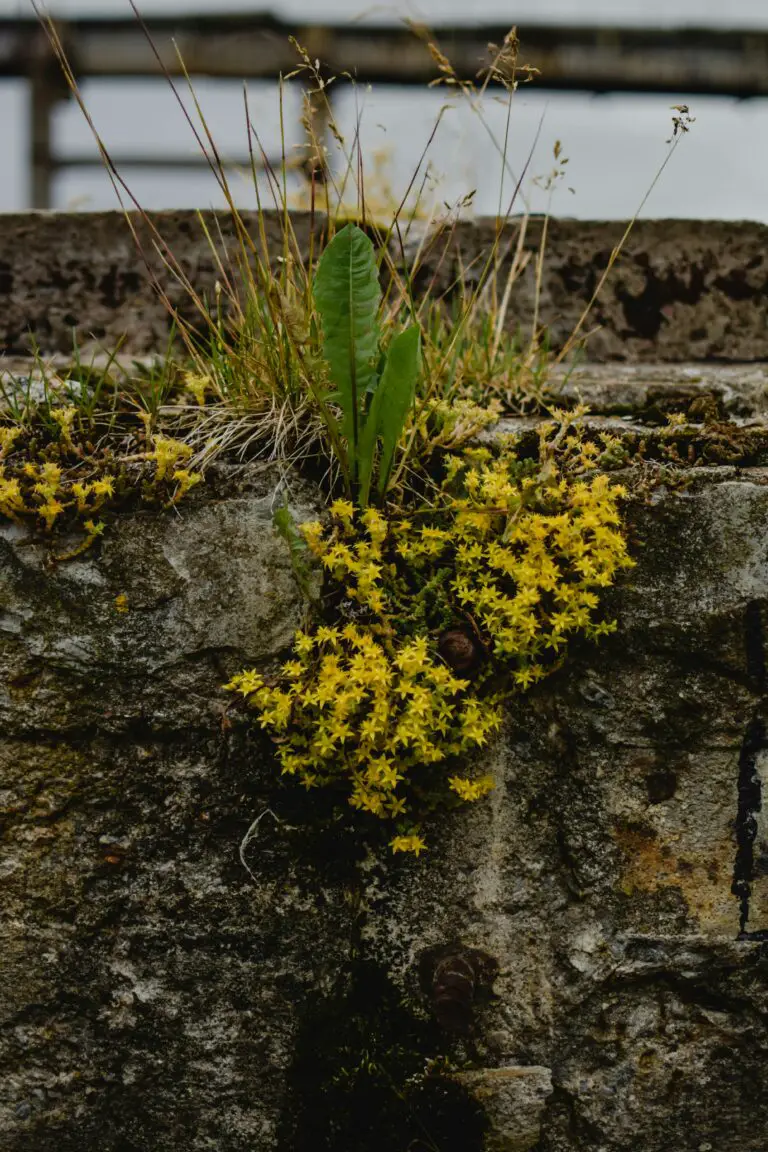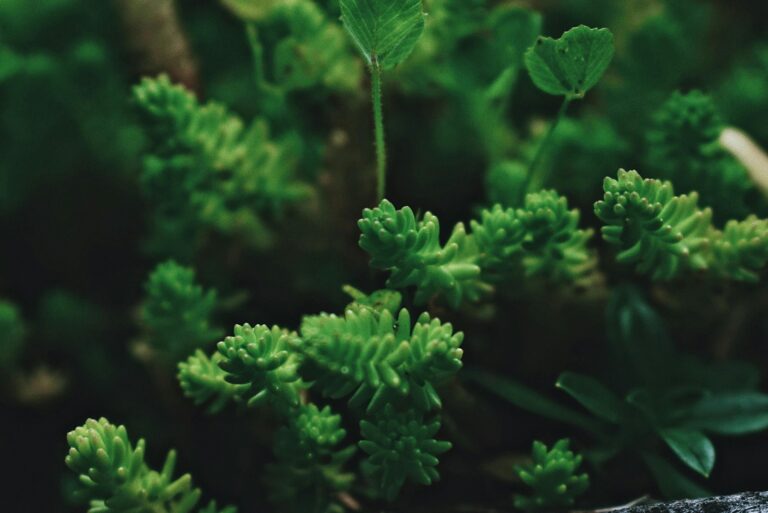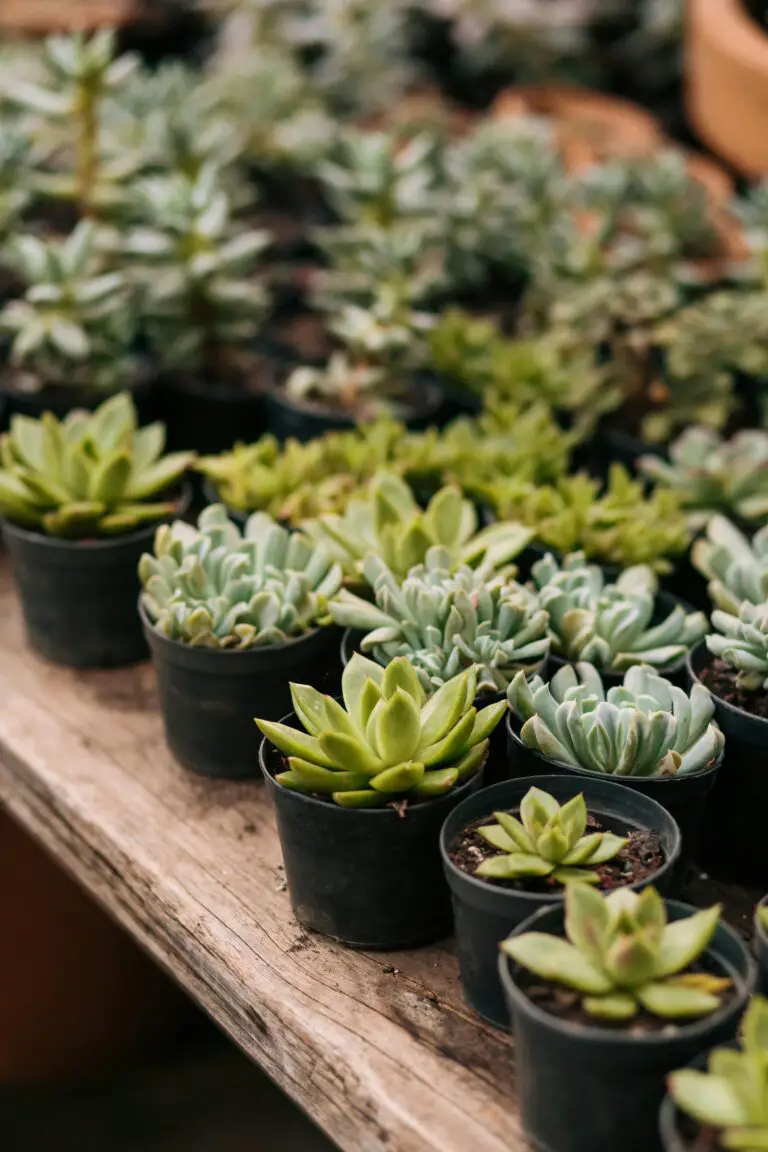Sedum’s Nomenclature: An Overview
Have you ever wandered in a garden and marveled at the variety of succulents sprinkled like jewels across the landscape? Among them, the sedum stands out with an aura of resilience and beauty. But, how did this captivating genus get its enchanting name? It’s time to peel back the layers of history and uncover the story behind the sedum nomenclature.
Sedum, often known as “Stonecrops,” suggests an affinity for rocky, inhospitable places where only the hardiest plants dare to settle. Their name is inspired by the Latin word “sedere,” which means to sit, perfectly encapsulating the way these plants nestle into stony nooks and crevices. Imagine tiny green outposts perched on a rugged cliff, quietly claiming the terrain as their own.
Each sedum is a survivor, a tiny green gladiator thriving in areas other plants would hastily retreat from. They are the living testimony to nature’s remarkable adaptability, their name echoing their tenacity. In your own garden, they’re the steadfast guardians of the floral realm, seldom demanding and always giving. From cascading mounds of Sedum morganianum to the starry explosions of Sedum spectabile, these succulents paint a picture of rugged beauty that enchants the eyes and captures the soul.
But it’s not just their tenacity in the face of arid environments or their ability to make the most of minimal moisture that makes sedum plants so fascinating. Their naming story lends a layer of depth to their character, transforming them from mere garden fixtures to storied members of the plant kingdom. It’s easy to see why they’ve become a staple in myriad gardens across the globe.
This section has explored the historical roots of the genus Sedum, delving into the reasons behind its naming and setting the stage for a rich appreciation of these diverse and tenacious succulents. The sedum’s tale is etched into its very name, inviting us to reflect on the intricate connection between nomenclature and nature’s marvels.
Unveiling Sedum’s Etymology
Have you ever stopped to ponder where the whimsical name “Sedum” comes from? Sit back as we trace the roots of this quirky moniker that aptly fits a plant characterized by its resilience and diversity. It’s a linguistic journey that takes us back to ancient tongues and botany.

At the heart of Sedum’s name lies the Latin language, a wellspring of terminology for the flora that clothes our planet. The term “Sedum” is derived from the Latin word “sedeo” which means “to sit,” a peculiar yet fitting association. Imagine a stonecrop, perched like a tranquil monk atop rocky outposts and walls, nonchalantly surveying its sun-drenched domain.
Why “to sit,” you ask? Well, picture the sedum plant’s modus operandi – inhabiting the tops of stones and walls as if it had settled down for a cozy rest, just “sitting” there, thriving where other plants might falter. Sedums exhibit a sense of stubborn endurance, gripping onto life in the most frugal of circumstances, making the most out of shallow soil and limited moisture.
Consider the cascading Sedums spilling over the sides of garden walls, an elegant demonstration of their “sitting” appellation. This mastery of balance, the art of living perched upon the sparsest of footholds, is essentially etched into their very name. The sedum’s ability to thrive with minimal fuss in crevices and crannies is a testament to the resilience encoded in their Latin title.
In the world of horticulture, names are whispers of characteristics. Sedum, with its fleshy, water-storing leaves, is often regarded as the ultimate survivalist of the plant kingdom. This is a plant that brings to life the notion of life “sitting” firmly in the face of adversity. And it’s this very essence that the ancient namers captured in the name “Sedum.” Through the years, the stoic stonecrops have lived up to their name, seemingly content in their unique ecological niches.
So there you have it, a stroll down etymology lane, where words blend seamlessly with nature’s wonders. And what a fitting name Sedum is, for a genus that doesn’t stray away from tough love, “sitting” resiliently, come rain or shine, in the most challenging of habitats.
The Rise of Stonecrops: Sedum’s Common Name
Have you ever wondered how the succulent sedum earned the endearing title of “Stonecrop”? Well, it’s quite the tale—a testament to both its resilience and its affinity for the less hospitable nooks of our planet. Picture this: a plant so hardy that it doesn’t just survive but positively thrives where few others can even dare to take root. That, my friends, is the essence of the sedum’s moniker.
Sedums, part of an extensive genus of over 400 species, have an innate ability to colonize areas that would spell doom for your average plant. These intrepid growers find a home in the craggy crevices of rocks, the arid expanses of gravelly roadsides, and even atop the unforgiving surfaces of urban rooftops. Imagine a plant so adaptable that concrete cracks in a bustling city become its preferred habitat; that’s the sedum for you!
But it’s not just their superhero-like adaptability that’s earned them the name Stonecrop. Sedums are also well known for their drought resistance. Their thick, fleshy leaves are where the magic happens: they store water, enabling these plants to endure long periods of dryness and conserve precious resources when most needed.

What’s more, these stoic survivors bring life and color to otherwise barren landscapes. In spring and summer, their clusters of star-shaped flowers bloom in a riot of colors, from sunny yellows to passionate pinks. Amidst a sea of gray stone and baked earth, the sight of a sedum erupting in full floral glory is both surprising and delightful.
So, when you’re contemplating the perfect plant to bring a touch of wild beauty to your rock garden or stone walkway, remember the hardy stonecrop. This unassuming but remarkable plant continues to spread its leaves and bloom where you’d least expect it, true to its name and nature.
Historical Context of Sedum
The story of how the resilient Sedum plant came to be known by its name is as robust and enduring as the plant itself. Like many botanical tales, it’s woven through with threads of folklore and practical use that have patterned its identity throughout the ages. As we delve into historical records and botanical texts, we can piece together a captivating chronicle of how this fascinating genus earned its moniker.
To begin our exploration, imagine yourself traveling back centuries, to a time when plants were not only categorized by their appearance but also by their utility and the lore that surrounded them. Sedum, a group of succulent plants, was no different. The simplicity and sturdiness of these plants—often found stubbornly growing on rocks and stone walls—inspired a name that echoed these characteristics.

In Latin, sedere means “to sit,” aptly describing the sedums or stonecrops as they are commonly known, which seem to sit comfortably atop stony perches. It’s not difficult to picture early botanists and herbalists, entranced by the sight of sedums perched upon ancient ruins or creeping along the edges of mossy rocks, being moved to name them based on this most distinctive of habits.
Our ancestors were no strangers to the rugged beauty of the sedums. In medieval gardens, they were valued not just for their hardiness in unwelcoming environments but also for their medicinal qualities. The sedums’ reputation for thriving where nothing else could led to beliefs that they possessed remarkable strength and resilience—qualities that made them popular in folk medicine and healing practices.
There is a certain charm in the historical use of Sedum as a robust cure-all, a plant that could ostensibly protect against lightning and witchcraft, according to old wives’ tales. Imagine the local apothecary, shelves lined with jars of dried herbs, providing sedum concoctions to ward off ailments or brewing up potions with this “life-everlasting” plant. Such practices reflect the mythology and respect afforded to the sedum over the ages.
Even in literature, sedums are celebrated. Poets and authors have paid homage to these unassuming yet steadfast plants, using their enduring, steadfast quality as metaphors for constancy and survival in the face of adversity. In the language of flowers, sedums communicate tranquility and peace—attributes that surely influenced their nomenclatural heritage.
As we stitch together these historical vignettes, it becomes evident that the name Sedum is as much a testimony to the plant’s survival across landscapes and eras, as it is a nod to its physical aspect. This intertwining of utility, lore, and botanical characteristics has cemented the name for generations, allowing us to appreciate the rich historical fabric behind the simple name of this rugged garden favorite.
Sedum’s Global Journey and Nomenclature
Like an intrepid explorer, the Sedum species embarked on a journey across continents, anchoring its roots in diverse terrains and cultures. But how did this globetrotter of the plant kingdom come to be known as ‘Sedum’? Let’s dig into the layers of earthy history and unravel this botanical tale.
Our story begins in the cradle of botanical nomenclature, where Latin and Greek served as the linguistic seeds. The term ‘Sedum’ is derived from the Latin word sedo, meaning “to sit.” This is a fitting tribute to its squat growth habit, comfortably perched atop rocky ledges and stone walls. Imagine these resilient plants as nature’s stony sentinels, stoically weathering the elements, comfortably nesting in their rocky domain.
The Sedum’s reputation for toughness is echoed in their common name, “Stonecrops.” This nickname is more than just a whimsical moniker; it’s a testament to their hardy disposition, sprouting in places where few other plants would dare to tread. Like a botanical phoenix, Sedum rises from the rocky rubble and thrives, embracing the harsh climes with a beauty that belies its ruggedness.
Everywhere it traveled, Sedum collected local names like souvenirs. In Japan, the charming Sedum is known as ‘Muramatsu-buta,’ alluding to its moss-like appearance on stone walls. In France, the ‘Orpin’ adorns rustic gardens, exuding a touch of je ne sais quoi with its succulent charm. And it’s not just the names that are diverse; the uses too are a tapestry of cultural ingenuity. From traditional medicine to green roof innovators, Sedum finds its niche.
Yet, the heart of Sedum’s identity lies in its scientific nomenclature, where each specific epithet whispers tales of discovery, appearance, or habitat. It’s a language sculpted by the hands of botanists past; a global lexicon where each name connects a patchwork of human experiences to this botanical globe-trotter.
For those looking to add Sedum to their personal anthology of greenery, comprehending their care is crucial. Dive deeper into proper care practices, and explore resources like “Seasonal Care Tips,” ensuring your verdant venture thrives.
Cemented in legend and science, Sedum’s tale is both a historic journey and a living dialogue between humankind and the Earth. Now, let’s bring this story to life with a visual aid. Below is a video that, while not solely dedicated to Sedum, encapsulates the allure of wildflower discovery and potentially highlights how plants make their global trek.
Embrace the journey further by gazing through the lens of a detailed look at container cultivation. Here, the ever-versatile Sedum demonstrates its adaptability, flourishing where other plants might falter.
As we’ve traversed from the annals of history to the present, the name ‘Sedum’ emerges not just as a term, but as a narrative woven through time, spanning continents and cultures, leaving a legacy etched in stone and soil.
Botanical Classification of Sedum
Have you ever marveled at Sedum’s resilient beauty and wondered what sets it apart from the rest of the succulent world? Well, it’s not just its striking appearance that distinguishes this plucky plant; it’s the intriguing classification story behind it as well. So, let’s delve into the botanical tapestry of Sedum—the genus that has carved out a unique niche within the vast plant kingdom.

At first glance, one might lump all succulents together, but take a closer look, and you’ll find that Sedum is a star player. This genus, part of the Crassulaceae family, holds a special rank due to its distinctive characteristics. Sedums, commonly known as Stonecrops, sport fleshy leaves meant to retain water, a life-saving trait for survival in rocky and arid environments.
What really sets Sedum apart is its versatility and adaptive prowess. Ranging from creeping groundcovers to towering hybrids, each species showcases a master class in survival tactics. Take, for example, the Sedum reflexum with its needle-like foliage, an architectural marvel that gives it an edge over its succulent competitors. Or the ever-captivating Sedum telephium with its stately flowers, which are not just a sight for sore eyes but also a beacon for pollinators.
Analyze any garden, and you’ll often find Sedum playing a crucial role; it’s a favorite amongst green thumbs for its low-maintenance persona and drought tolerance. A closer inspection of their leaves reveals a cellular structure designed like nature’s own water-storing vessels, making them efficient in ways not seen in other succulents. It’s these attributes—unique to the Sedum genus—that merit their standout classification.
So, the next time you spot a Sedum seducing the senses with its verdant charm or rugged elegance, remember, it’s not just another succulent. It’s a botanical wonder that has charmed its way into the hearts of plant enthusiasts and garden landscapes alike.
The Scientific Significance of Naming Flora
In the grand tapestry of botany, every thread—each plant species—carries a story, not just in its existence, but also in the name it bears. This is particularly true for Sedum, a genus of succulents more fondly known as “stonecrops.” But have you ever stopped to mull over the importance of these botanical labels? Why not join me on a verdant voyage into the heart of scientific significance where we dissect the nomenclature of nature’s green children, like Sedum?
Imagine walking through a bustling garden of bewildering biodiversity. You’re greeted by a panoply of plants, each distinct in form and function. Now, suppose you stumble upon a captivating cluster of fleshy leaves, crowning petite yet profound flowers—ah, you’ve encountered a Sedum! But here it is, not just a visual treat but a nomenclature puzzle awaiting your curious mind. What does this name announce to the world, and why does it deserve a spot in the echelons of scientific spotlight?
Scientific naming, my friends, is far from arbitrary. It’s a meticulous method that brings order to chaos, enabling botanists and enthusiasts alike to navigate the lush labyrinth of plant life. Take Sedum as an exhibit: its name is derived from the Latin “sedeo,” meaning “to sit.” This is in homage to its typical posture, nonchalantly lounging atop rocks and rugged terrains as if nature herself had placed a green, ornate cushion over the stone. This specific name unravels a tale about its habitat and lifestyle, a tiny yet vital piece of botanical biography.
But it’s not just about storytelling. This method of categorization illuminates the relationships between species, hinting at shared ancestry and evolutionary pathways. When you hear Sedum, you’re not just being introduced to a singular plant; you’re meeting a vast assembly of related species, united under a common banner of survival strategies and ecological adaptations. This lineage, beautifully captured in a name, serves as a gateway to a deeper understanding of plant dynamics and biodiversity.

Indeed, when we speak the language of Linnaeus—the father of taxonomy—we are not merely stringing syllables. We are bearing witness to a sophisticated system that allows anyone, anywhere, to speak of Sedum and be understood universally. Think of it as a botanical Esperanto, sans borders and barriers, fostering global dialogue and discovery—a testament to the power of naming.
So, as we delve into the verdant valleys and scale the stony slopes where Sedum serenely sits, let us appreciate the profound simplicity and profound depth encapsulated within its name. It is, after all, through such significant scientific nomenclature that we engage with the peculiar personalities of the plant kingdom, one evocative epithet at a time.
Cultivating Understanding: Sedum in Modern Gardens
An exploration of the current popularity of Sedum species in gardening and landscaping, emphasizing the features that make them so beloved and recognizable, is not just about highlighting a trend – it’s about uncovering the charm and resilience that has propelled these succulent plants, also known as Stonecrops, into the limelight of modern horticulture. As we delve into the leafy cradle of these diverse plants, their story unfolds, one garden plot at a time.
Considered botanical diamonds for their hardiness and ornamental qualities, Sedums have become the go-to choice for innovative landscapers and environmentally conscious gardeners. Picture the rooftops of urban structures, once barren and unremarkable, now teeming with the green vibrancy of Sedum mats. These plants not only add aesthetic value but also play a crucial role in creating sustainable, living architecture that cools buildings and cleans the air, all while demanding minimal upkeep.
Why Sedum Stands Out in the Garden
In the private sphere, Sedums are transforming domestic gardens with their unique ability to thrive where other plants might falter. Their secret? An extraordinary drought tolerance, thanks to succulent leaves that store water, allowing them to persevere through the harshest of summer scorchers. Moreover, with a spectrum of colors from the brightest greens to deep burgundy, alongside blooms that range from subtle whites to electrifying pinks, Sedums offer a palette to satisfy any gardener’s visual appetite.
Real-life examples abound. Take, for instance, the backyard enthusiast who replaced a labor-intensive lawn with a sea of variegated Sedum. Not only did they cut down on water consumption and maintenance time, but they also amplified the local ecosystem’s diversity by inviting a symphony of pollinators with the seductive blooms of ‘Autumn Joy’ and ‘Black Jack’ Sedum varieties.

It’s not just about individual projects—entire communities are coming together, driven by a collective eco-conscious spirit, planting Sedums to green their shared spaces. From neighborhood parks to schoolyard gardens, Sedums are making a splash with their unmatched adaptability and low-maintenance charm. They’re a testament to the concept of “plant it and forget it,” serenely spreading over time, providing year-round interest with minimal intervention from human hands.
The appeal of Sedum in modern gardens extends beyond their ecological benefits and visual allure. These steadfast plants exhibit a tenacious spirit that resonates with those who encounter them. They’re a symbol of nature’s ingenuity, a beacon of sustainability, and a vibrant mainstay in the evolving narrative of gardening. In Sedums, we find a connection to the earth that is as enduring as the very rocks they’re named after.
Frequently Asked Questions
When it comes to the charming succulents known as Sedum, or the whimsical ‘stonecrops,’ curiosity blooms as brightly as their star-shaped flowers. How did Sedum get its name, you might wonder as you gaze upon these resilient beauties, each one a survivor thriving where others might barely sprout. Well, let’s dig into the etymology, the care, and the quirks of these delightful plants!

What’s in a Name? Sedum’s Etymological Roots
Picture this: ancient rockeries where only the hardiest of plants could take hold. Sedum’s moniker springs from such gritty origins, with a nod to Latin ‘sedere,’ meaning ‘to sit.’ Fitting, isn’t it? These plants quite literally sit atop rocky outcrops, embodying resilience in the plant kingdom. Every time you spot a Sedum, remember that this little trooper is basically nature’s way of sitting pretty against all odds.
Caring for Sedum: A Breeze for Gardeners
Is your thumb more brown than green? Fear not, for Sedum forgives the forgetful waterer. Spare a thought for these succulents only occasionally and they’ll flourish. Imagine a plant that tolerates drought just as a camel would in the desert. It’s no wonder that amateur gardeners sing praises to the Sedum, as it asks for so little yet gives back a tapestry of colors and textures to any garden, balcony, or windowsill.
From Stones to Stars: The Versatility of Sedum
Adaptability is the game, and Sedum is the name! Whether you’re paving a pathway with greenery or topping off a green roof to make your neighbors go green with envy, Sedum flexes to fit your vision. It’s a testament to versatility; a single plant that can morph from a humble groundcover to a show-stopping element in sophisticated landscape designs. Real-life garden transformations showcase Sedum’s star power as both a durable and decorative ace.
Sedum’s Wide World of Varieties
Did you think Sedum was a one-note wonder? Think again! With over 400 species, there’s a Sedum out there for every garden scenario. Some cascade like a green waterfall from hanging baskets, while others stand upright, their jewel-toned leaves a statement in any space. It’s a botanical buffet as diverse as the flavors in a well-stocked spice rack, each variety adding its own zest to your garden concoction.



